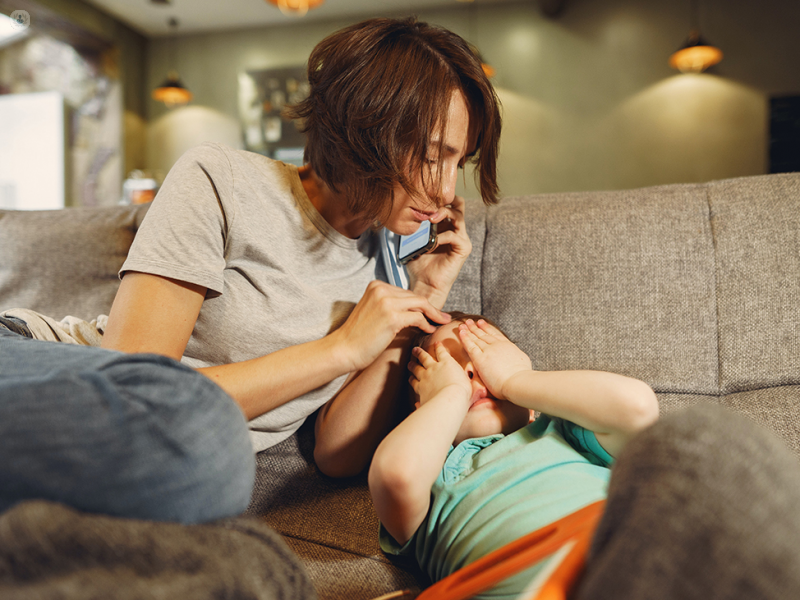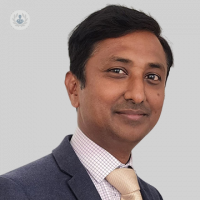Headaches in children: when should you worry?
Written by:Headaches can affect children in many ways. In addition to the actual pain, they can cause a huge disruption to the child's daily routine and relationships and negatively affect their overall wellbeing.
In this article, Dr Basheer Peer-Mohamed, a senior consultant paediatrician based at BMI The Saxon Clinic in Milton Keynes, walks us through some of the most common causes of headaches in children, the types of symptoms they can experience and at what point you should consider taking them to a doctor.

Do children develop headaches similarly to adults?
Yes, children can develop headaches similar to adults. In fact, some longitudinal studies have shown that about 10 to 15% of children can experience substantial periods of headaches. Children as young as five or six years of age can also develop headaches.
What are some common causes of headaches?
Headaches in children primarily fall under the category of nonspecific headaches. This means there are usually no underlying serious medical problems. In these children, headaches are usually caused by lifestyle, environmental or psychological factors. For example:
- A disruption to the daily routine of the child could bring about headaches. This could be in the form of lack of adequate sleep or a problem with eating healthily and at appropriate times.
- Sometimes, children do not drink enough water, especially during hot summers. When these sort of disruptions persist for longer than a reasonable length of time, then children can develop headaches.
- Continuous viewing of fast moving images, such as in video games can prevent certain parts of the brain from having adequate rest which can manifest as headaches.
- Poor posture brought on by continuous use of hand held electronic devices such as smart phones can also lead to pressure on neck muscles and surrounding tissues which can manifest as headaches.
- Stress can also play a big role in triggering headaches. Children might perceive stress either from the school environment because of difficulties with schoolwork or because of other issues such as bullying.
- Similarly, problems in the home environment can cause headaches. Major life events or a strained relationship with siblings, parents or extended family members can also have an impact on the child's health, resulting in chronic headaches.
How do headaches affect children?
Headaches can affect a child in several ways. Apart from the actual pain, they can cause a huge disruption to the child's daily routine and affect their ability to concentrate on schoolwork or the physical activities they enjoy.
Headaches can also make children feel tired and cranky, irritable, and affect their quality of sleep. This can consequently harm their relationships with their peers at school and family members which often descends into a vicious cycle.
Can children experience migraines?
Yes, a migraine is another common type of headache that we see in children. Often, there is a family history of migraines. For example, one or both parents, uncles or grandparents might have suffered from her migraine headaches in the past. Sometimes, however, there might not be a positive family history of migraine.
What are the signs and symptoms of migraines in children?
Migraine headaches are quite typical in that they occur in an episodic nature maybe once every two or three weeks. An older child will usually point to a specific location on the head to describe the headache, which usually remains the same with each attack. In younger children, migraine headaches tend to affect both sides of the head.
Often the child will experience a sense of nausea or actual vomiting that is associated with the migraine. The child is usually quite debilitated by the severity of the headache and often have to lay down in a quiet room or sleep for a variable amount of time - usually, at least a few hours before they wake up with a significant reduction in the intensity of the headache. Sometimes though, the migraine can last for two or three days, which can lead to missed school days.
Visual aura
The child might have other neurological symptoms before the onset of headaches. A common symptom is a visual aura in which flashing lights appear in the child’s visual field. They usually move from the periphery of their visual field to the centre. Occasionally, they join up together and other times, they appear as zigzag lines moving around the visual field.
Usually, these aura symptoms appear at least a few minutes before the onset of the headache. This can therefore allow us to use medications to halt the onset of the headache before it begins.
Can headaches ever be a sign of an underlying health problem?
Headaches aren’t usually serious, however, there are times when they can be a sign of other medical problems in children:
- Refractive errors affecting the visual acuity — the child might have to often strain to look at their schoolwork, and because of this constant strain, the child might provoke headaches.
- Dental problems — cavities and infections in the mouth can trigger headaches in children.
- Recurrent or chronic ear problems — ear infections can irritate the nerves around the head and contribute to headaches and migraines.
- Persistently abnormal head and neck posture — This might indicate a serious cause for the headache.
- Low or high blood pressure — unidentified low or high blood pressure can also present as headaches in children.
- Tumours or obstructions — it is rare but an increase in the pressure within the brain, such as from tumours or due to an obstruction to the flow of the cerebral spinal fluid which beds and cushions the brain can also cause headaches.
- Medication overuse headache — if the child has to take painkiller medications regularly, then it can lead to a condition known as medication overuse headache.
These are usually called secondary headaches and it is important to identify the primary underlying medical problem that is causing them.
How can you treat a child’s headache at home?
If a child has the odd episodes of headaches, occurring roughly once every couple of months, and they don’t have any other worrying symptoms then you can usually manage the headaches at home. You should ensure that the child:
- gets plenty of rest
- takes regular breaks from any strenuous or exhausting activities
- has at least eight hours of sleep
- drinks plenty of water
- reduces the amount of time spent in front of electronic screens such as video games or smartphones
If needed, parents can use painkillers such as paracetamol or Calpol.
When should I be concerned about my child's headaches?
You should seek medical assistance if the child is experiencing the following:
- severe and frequent headaches
- headaches accompanied by vomiting
- early morning headaches or headaches that wake the child up in the middle of their sleep problems with their vision
- any significant changes to the normal emotional and behavioural pattern
- any neurological problems such as unsteadiness when walking or standing
- any weakness in the arms and legs or any sensory problems such as tingling or numbness of the hands and feet
- any problems with the bladder and bowel control
How do you diagnose the cause?
In terms of assessment for headaches, I would usually take a detailed history of the symptoms from both the child and the parents or guardians. By looking at their medical history, I can aim to identify what might be causing the headaches. I will also look at their daily routine to try and identify any environmental or psychological factors that might be causing the headache. I will also explore the presence or absence of specific symptoms in order to ascertain if the headache is secondary to an underlying medical problem.
This would then be followed by a thorough clinical examination, including an examination of the neurological system and the assessment of the other systems to rule out underlying medical causes. An ophthalmoscopic assessment, which is a non-invasive assessment of the back of the eyes or the retina, will also be carried out to exclude any raised pressure within the brain and the surrounding structures.
At the end of the clinical assessment, it will be possible to make a diagnosis of the type of headache the child has and a treatment plan can then be formulated.
Sometimes the cause for the headache may not be obvious or it may well be that a secondary headache could not be excluded based on the clinical assessment, in which case an MRI scan would be helpful to complete the assessment.
If you are worried about your child’s headaches and would like them to see a specialist, visit Dr Basheer Peer-Mohamed’s Top Doctors profile and book an appointment to see him.


